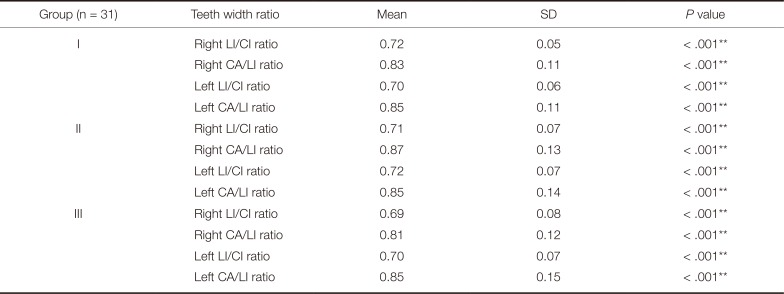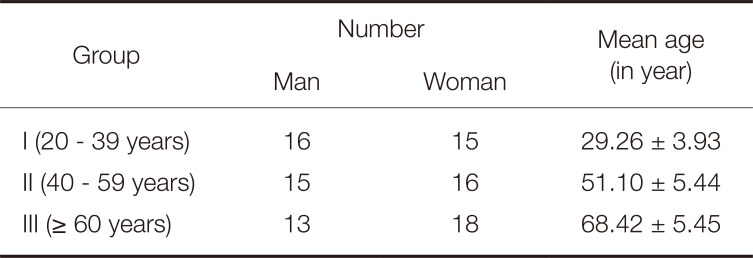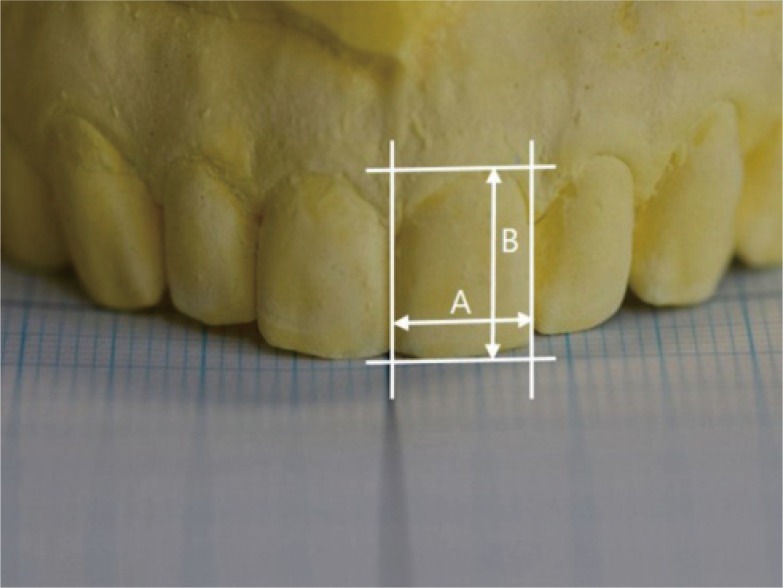1. Goldstein RE. Study of need for esthetics in dentistry. J Prosthet Dent. 1969; 21:589–598. PMID:
5254499.

2. Ku JE, Yang HS, Yun KD. A morphometric analysis of maxillary central incisor on the basis of facial appearance in Korea. J Adv Prosthodont. 2012; 4:13–17. PMID:
22439095.

3. Lombardi RE. The principles of visual perception and their clinical application to denture esthetics. J Prosthet Dent. 1973; 29:358–382. PMID:
4570911.

4. Levin EI. Dental esthetics and the golden proportion. J Prosthet Dent. 1978; 40:244–252. PMID:
279670.

5. Ricketts RM. Divine proportion in facial esthetics. Clin Plast Surg. 1982; 9:401–422. PMID:
7172592.

6. Preston JD. The golden proportion revisited. J Esthet Dent. 1993; 5:247–251. PMID:
7993669.

7. Gillen RJ, Schwartz RS, Hilton TJ, Evans DB. An analysis of selected normative tooth proportions. Int J Prosthodont. 1994; 7:410–417. PMID:
7802908.
8. Ali Fayyad M, Jamani KD, Agrabawi J. Geometric and mathematical proportions and their relations to maxillary anterior teeth. J Contemp Dent Pract. 2006; 7:62–70. PMID:
17091141.
9. Rosenstiel SF, Ward DH, Rashid RG. Dentists' preferences of anterior tooth proportion-a web-based study. J Prosthodont. 2000; 9:123–136. PMID:
11179463.

10. Hasanreisoglu U, Berksun S, Aras K, Arslan I. An analysis of maxillary anterior teeth: facial and dental proportions. J Prosthet Dent. 2005; 94:530–538. PMID:
16316799.

11. Sterrett JD, Oliver T, Robinson F, Fortson W, Knaak B, Russell CM. Width/length ratios of normal clinical crowns of the maxillary anterior dentition in man. J Clin Periodontol. 1999; 26:153–157. PMID:
10100040.

12. Tsukiyama T, Marcushamer E, Griffin TJ, Arguello E, Magne P, Gallucci GO. Comparison of the anatomic crown width/length ratios of unworn and worn maxillary teeth in Asian and white subjects. J Prosthet Dent. 2012; 107:11–16. PMID:
22230911.

13. Ward DH. Proportional smile design using the recurring esthetic dental (red) proportion. Dent Clin North Am. 2001; 45:143–154. PMID:
11210692.
14. Jin MX, Hong MH, Lee KJ, Lee KB. Does the maxillary anterior ratio in Korean adults follow the Golden Proportion? J Adv Prosthodont. 2016; 8:125–130. PMID:
27141256.

15. Lee SP, Lee SJ, Hayashi K, Park YS. A three-dimensional analysis of the perceived proportions of maxillary anterior teeth. Acta Odontol Scand. 2012; 70:432–440. PMID:
21780976.

16. Magne P, Gallucci GO, Belser UC. Anatomic crown width/length ratios of unworn and worn maxillary teeth in white subjects. J Prosthet Dent. 2003; 89:453–461. PMID:
12806322.

17. Al-Marzok MI, Majeed KR, Ibrahim IK. Evaluation of maxillary anterior teeth and their relation to the golden proportion in Malaysian population. BMC Oral Health. 2013; 13:9. PMID:
23347800.

18. Kook YA, Nojima K, Moon HB, McLaughlin RP, Sinclair PM. Comparison of arch forms between Korean and North American white populations. Am J Orthod Dentofacial Orthop. 2004; 126:680–686. PMID:
15592215.

19. Nojima K, McLaughlin RP, Isshiki Y, Sinclair PM. A comparative study of Caucasian and Japanese mandibular clinical arch forms. Angle Orthod. 2001; 71:195–200. PMID:
11407772.
20. Schierz O, Dommel S, Hirsch C, Reissmann DR. Occlusal tooth wear in the general population of Germany: effects of age, sex, and location of teeth. J Prosthet Dent. 2014; 112:465–471. PMID:
24636759.

21. Yun HJ, Jeong JS, Pang NS, Kwon IK, Jung BY. Radiographic assessment of clinical root-crown ratios of permanent teeth in a healthy Korean population. J Adv Prosthodont. 2014; 6:171–176. PMID:
25006380.

22. Peixoto LM, Louro RL, Gomes AA, do Nascimento APC. Photographic analysis of esthetic dental proportions. Rev Gaucha Odontol. 2012; 60:13–17.
23. Cooper GE, Tredwin CJ, Cooper NT, Petrie A, Gill DS. The influence of maxillary central incisor height-to-width ratio on perceived smile aesthetics. Br Dent J. 2012; 212:589–599. PMID:
22722122.

24. Hattab FN, Yassin OM. Etiology and diagnosis of tooth wear: a literature review and presentation of selected cases. Int J Prosthodont. 2000; 13:101–107. PMID:
11203616.
25. Donachie MA, Walls AW. Assessment of tooth wear in an ageing population. J Dent. 1995; 23:157–164. PMID:
7782527.

26. Tezal M, Wactawski-Wende J, Grossi SG, Ho AW, Dunford R, Genco RJ. The relationship between bone mineral density and periodontitis in postmenopausal women. J Periodontol. 2000; 71:1492–1498. PMID:
11022780.









 PDF
PDF ePub
ePub Citation
Citation Print
Print







 XML Download
XML Download